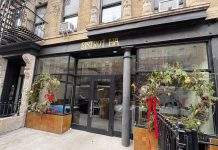

“I don’t want to be here,” said Danny Perez, former principal of Nativity Mission Center middle school, “going through files and looking at pictures and thinking about what was here; what could have been here if we could have stayed; what more we could have done.”
Sitting in his cluttered office in the school’s Forsyth Street home, surrounded by boxes in need of packing, he was voicing unfamiliar feelings. Perez graduated from Nativity in 1998 and returned soon after college to serve as a Spanish teacher and guidance counselor before becoming principal in 2011. Last month, he witnessed the departure of the 16 young men who comprise Nativity’s latest and final graduating class. After more than 40 years on the Lower East Side, the school has closed for good.
Operated by Jesuits since 1971, Nativity Mission Center School has supplied hundreds of boys from low-income households with educational opportunities at relatively little cost to their families. (The school charges only $75 dollars per month, making up the rest of each child’s $15,000 yearly tuition through private donations).
The Nativity model, designed to “break the cycle of poverty,” extends beyond the hours of the school day to include after school activities and tutoring, as well as a 5-week summer camp. Housed in a former tenement building owned by the Archdiocese of the New York, the school can only accommodate about 50 students at a time. Yet its success on the LES inspired the founding of more than 60 schools in the Nativity model nationwide, and the school’s leadership has branched out to new locations in the city. The New York Nativity Network now includes middle schools Brooklyn and in the Bronx.

So when the network’s board of trustees decided to stop accepting students at its original Nativity school in the winter of 2010, some questioned why the time-honored institution was leaving its original home on the Lower East Side. The network’s answer: gentrification had pushed families in need of Nativity’s services out of the neighborhood. While household income on the LES remains well below the citywide average, school officials pointed out that the community had undergone dramatic changes over the course of the past 25 years.
“We are meant to be in an ‘in-need’ area,” explained Father Jack Podsiadlo, who first began teaching at Nativity in 1973 and served as President of the New York Nativity Network for four years before recently shifting his role to Director of Mission and Ministry. “When we first started Nativity, that census tract (surrounding the school at 204 Forsyth) was the poorest in the city of New York.”
He recalled the neighborhood’s days of rampant drug use and prostitution, when the Nativity building served as an oasis of safety for students. Now, he said, low-income families have moved away under the pressure of gentrification, and even the area’s rent-stabilized housing projects are home to fewer poor families with young children than they once were.
“People say, ‘Get kids to come from the projects.’ But a lot of those apartments are held by elderly people now,” he noted. In addition, Father Jack said, charter schools have emerged on the Lower East Side, whereas some of the city’s poorer neighborhoods are more lacking in alternatives to large, under-performing public schools.
“We used to have more than 90 percent of our students from a 5-block radius,” said Perez, “and that has changed to the point where 70-80 percent of our guys are not from this neighborhood. We have guys from way up on 10th Street; we’ve had guys from Chinatown in the past. But now we also get guys from Brooklyn and Queens, from Harlem or the Heights.”

According to Glenn Pellino, assistant to the president of the Nativity Network, changing demographics on the Lower East Side began to conflict with the Nativity Mission model, which envisions schools deeply tied to the communities in which they are located. “Clearly what was happening was we were accepting more and more students from outside the Lower East Side. A third of our students were commuting from other parts of Manhattan or even Brooklyn,” he said. This reality made it far more difficult for the school to do what it had done so well in the past: to cultivate relationships with families in impoverished areas. “We prefer to have neighborhood schools and not magnet schools,” Pellino said, “so that we can have the relationship with parents that we want.”
Concerns about the decreasing number of families to serve in the immediate area coincided with the financial crisis in 2007. Donors generally committed less to the school in the years that followed, but a drop in funds from Wall Street businessmen, once a crucial source of income, was an especially big setback. “We had pooled all our resources in that one specific area and were struggling to find new donors, donors that would be long-term,” said Perez. “We want donors who are not just giving away their bonuses as a write-off, but really care about our institution. I’m not saying we weren’t grateful for those Wall Street donations, but we realized we needed to start branching out.”
In the face of mounting fiscal difficulties, the price of educating each student at the Nativity Mission School became problematic. Because the building can house fewer than 50 students, the cost per pupil is relatively high. “In the end, it comes down to money,” said Perez. “We have three locations in the Nativity Network, and of the three locations (the LES school was the most costly) because of the low number of students.” Saint Ignatius (in the Bronx) and Brooklyn Jesuit Prep each serve around 85 students every year. “Those schools are thriving because they have a bigger facility; they have a bigger building,” he said. In 2010, the decision to close the school was finalized.
Though Perez understands the factors that informed the board’s decision to vacate the building on Forsyth, he’s sad to see his alma mater exit the Lower East Side. Perhaps with more targeted outreach efforts, he said, the school might have found a greater number of needy students in the neighborhood (the school relied primarily on word-of-mouth communication within the Catholic community to publicize itself). “I do truly believe we could have continued the mission here,” he said. “We do want to expand though. We want to have a bigger facility, we want to have boys and girls.”
In fact, the New York Nativity Network has been looking to establish a new school in one of the city’s poorest areas since electing to close its Forsyth Street facility. The network’s leadership has seriously considered establishing a Nativity model school in Elmhurst, Queens or Hunts Point in the Bronx, part of the nation’s single poorest congressional district. But finding the right facility at the right price is complicated. “We cannot afford to build a school building,” said Glenn Pellino. “We depend on being able to find space that can be readily adapted to meet the needs of a school.”
What about the future of the Forysth Street building? Though a spokesperson for Archdiocese declined to describe any ongoing negotiations involving the property, real-estate developer Charles Saulson, who recently purchased a neighboring recreational yard, is believed to be eying the property. Father Podsiadlo said he understands there’s a plan to demolish the school building, replacing it with a new mixed-use (residential and retail) development.









